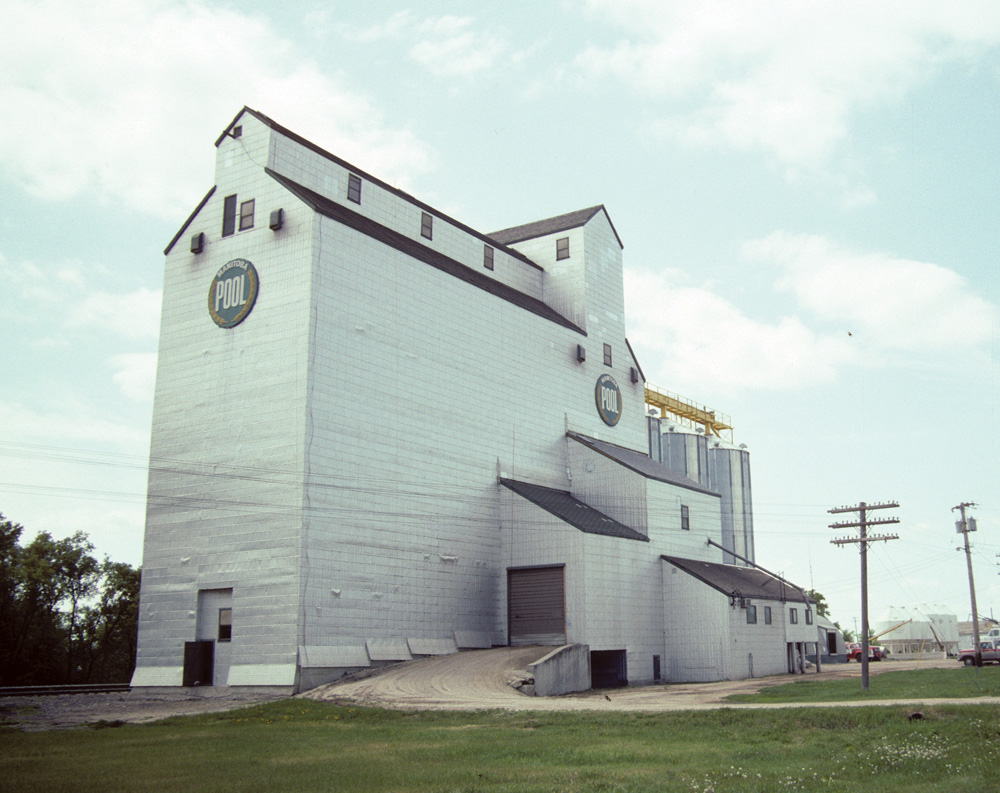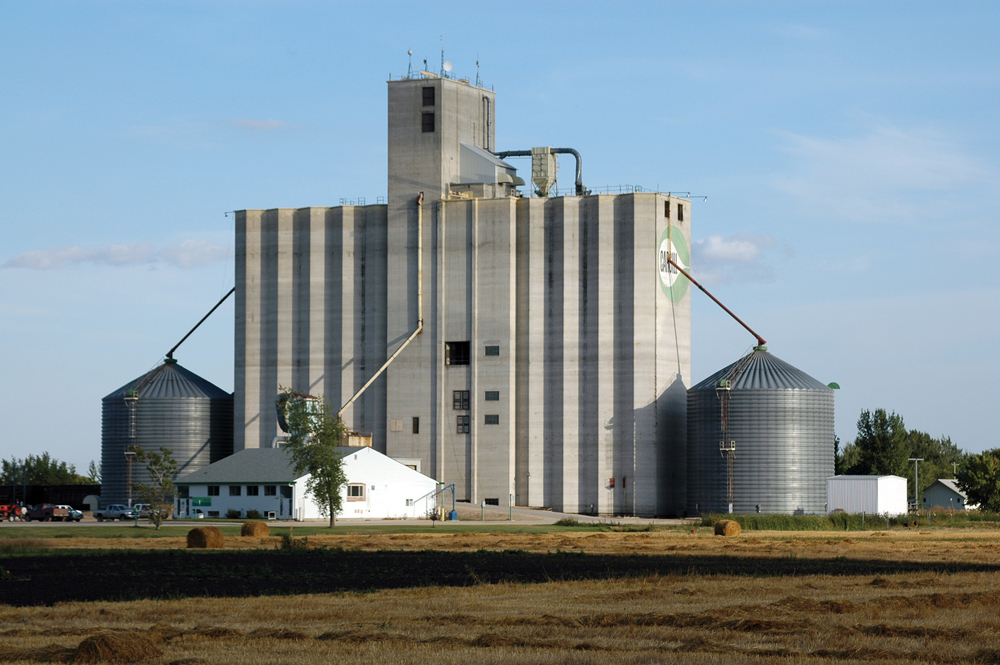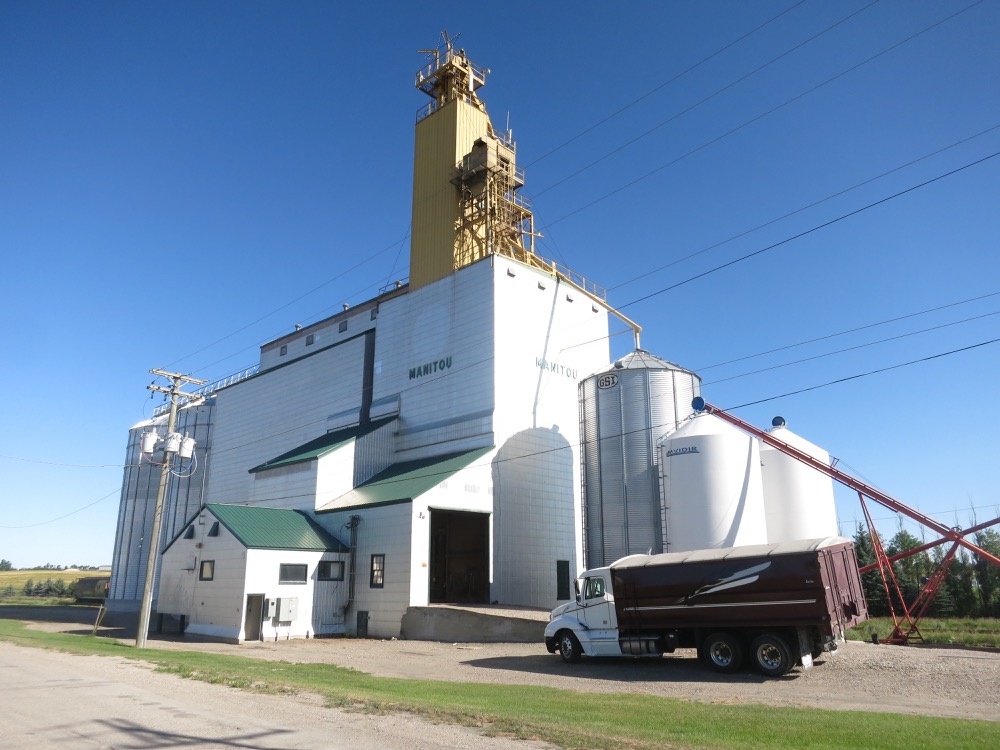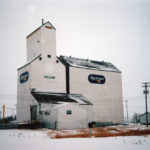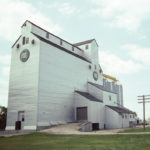
A wooden elevator at Holland was built in 1927 by a local co-operative working with Manitoba Pool Elevators. Its modest 50,000-bushel capacity was enlarged with a squat 75,000-bushel balloon annex in 1952 and a taller 85,000-bushel crib annex in 1958. The elevator was renovated thoroughly in 1982 and the balloon annex was removed around 1994. It survived the transfer to Agricore in 1998 but closed in early 2001 and was demolished in December 2003.
Photo: John Friesen
The former Manitoba Pool elevator at Oakville, seen here in a 1992 photo, was built between 1974 and 1975 to replace an elevator from 1928 destroyed by fire. An early example of the wooden composite type in which the elevator and annex are built as one solid crib, three steel tanks were added in 1990, increasing its capacity from 162,000 to 204,000 bushels. The facility continued to operate after the corporate merger that formed Agricore in 1998, but was closed temporarily in January 2001 as a cost-cutting measure then closed permanently in November 2001 after the Agricore merger with United Grain Growers. It is now used for private grain storage.
Photo: Historic Resources Branch
The Cargill elevator at Elm Creek is considered the “granddaddy” of the concrete terminals that now dominate the Prairie landscape. Built in 1976, along with an identical twin at Rosetown, Saskatchewan, the elevator had an initial 460,000-bushel capacity, by far the largest of any country elevator in Manitoba at that time. It had been built using a slipform process that was increasingly popular for the construction of large, concrete structures across Canada, including Toronto’s CN Tower. The elevator’s capacity was increased over 40 per cent over the next few years but it is now dwarfed by other terminals up to five times its size.
Photo: Bernie Freeman (2007)
A former Manitoba Pool elevator at Manitou was built between February and September 1988, replacing two elevators at the site, a 62-year-old crib moved here from Kaleida in the fall of 1965, and a former Ogilvie Milling elevator. Joining a 100,000-bushel annex constructed in 1977, total capacity of the new facility was 143,400 bushels. In 2005, its adjacent railway was to be abandoned by the CPR. The line between Manitou and Killarney could not be saved but, just as rail removal between Manitou and Morden was to commence in late 2008, a group including local farmers successfully established a short line railway to continue servicing the elevator, now owned and operated locally, along with producer-car loading sites at Binney, Manitou, and Darlingford.
Photo: Gordon Goldsborough
In the 1950s, there were over 700 grain elevators in Manitoba. Today, there are fewer than 200. You can help to preserve the legacy of these disappearing “Prairie sentinels.”
The Manitoba Historical Society (MHS) is gathering information about all elevators that ever stood in Manitoba, regardless of their present status. Collaborating with the Manitoba Co-operator it is supplying these images of a grain elevator each week in hopes readers will be able to tell the society more about it, or any other elevator they know of.
MHS Gordon Goldsborough webmaster and Journal editor has developed a website to post your replies to a series of questions about elevators. The MHS is interested in all grain elevators that have served the farm community.
Read Also

Grain seller beware
Canadian farmers selling grain need to be vigilant while doing business in an unstable financial climate.
Your contributions will help gather historical information such as present status of elevators, names of companies, owners and agents, rail lines, year elevators were built — and dates when they were torn down (if applicable).
There is room on the website to post personal recollections and stories related to grain elevators. The MHS presently also has only a partial list of all elevators that have been demolished. You can help by updating that list if you know of one not included on that list.
Your contributions are greatly appreciated and will help the MHS develop a comprehensive, searchable database to preserve the farm community’s collective knowledge of what was once a vast network of grain elevators across Manitoba.
Please contribute to This Old Grain Elevator website here.
You will receive a response, by email or phone call, confirming that your submission was received.
Goldsborough is interested in hearing all sorts of experiences about the elevators — funny, sad, or anything in between. Readers willing to share their stories can leave messages at 204-474-7469.





